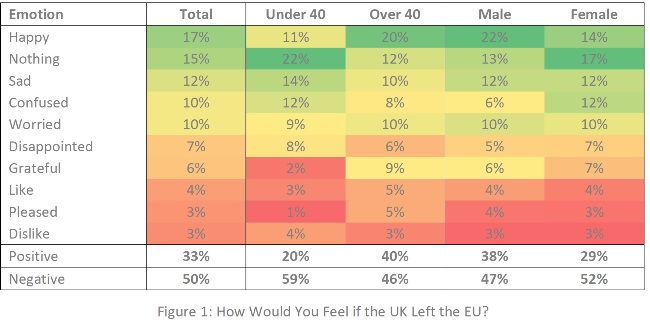Emotalizer: Leaving the European Union
Posted: 02/09/2015

“Farage delights as Cameron accepts recommendations to change the Brexit Referendum wording, but the wording won’t be the deciding factor”

Within the next two years Britons will get to vote on whether the United Kingdom will remain a member the European Union. The Conservative Party manifesto pledges to hold this Brexit referendum before the end of 2017 and David Cameron is rumoured to be announcing a date in July 2016 at the Tory party conference in October.
Polls to-date have yielded inconsistent results. The largest poll (by Lord Ashcroft Polls in March 2014 n = 20,000) found a 41-41-18 split between leaving, staying and undecided. Our poll (July, 2015 n = 1,136), which was a forced Yes or No response, found 42-58 split between leaving and staying. We found that younger, higher income Londoners who regularly watch the Eurovision Song Contest are more likely to want to stay in the EU.
The wording of the referendum was released by Downing Street in May, stating that the British public will be asked whether they wish to “remain a member of the European Union”. Yesterday, however, David Cameron accepted the recommendation from the Electoral Commission that this wording be changed so that voters are asked whether Britain should remain a member of the EU or leave the EU, replacing the Yes and No responses and their corresponding campaigns.
This recommendation is based on a perception of bias that Yes/No voting would favour the status quo, and there is a regular debate around whether it’s easier to run a campaign with positive or negative framing (i.e. whether the referendum is yes-to-stay/no-to-leave or vice versa). With this in mind we asked the Brexit Referendum question in both directions, and found that these two frames yield identical voting patterns, showing these wording changes to have no impact on results.
Looking at the issue through the more colourful lens of people’s emotional reactions to a Brexit, the figure shows that the most commonly cited emotion is Happiness. Overall, however, only 33% of the sample cited positive emotions and 50% cited negative emotions including Sadness, Disappointment and Worry.
This last emotion, anxiety over any exit, may play a significant role in the campaign. It resonates with equivalent research we undertook during the campaign for Scottish independence. At the time we suggested that the social awkwardness of confessing to fearing an outcome (compared to how people would behave in the privacy of a polling booth) created a tendency for polls to overstate the chances of a Scottish exit. In the end, there was indeed a 3-9% gap between opinion polls and the final ballot.
As such, the chances of a Brexit are probably even lower than what we’ve reported. However, because of the natural volatility in polls over time and this propensity for polls to over-state the chances of an exit, we anticipate significant uncertainty and some periods where a Brexit appears the more likely outcome, between now and the vote.